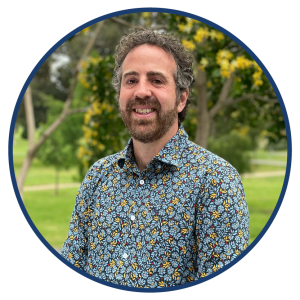
By Nikki Babri
The 2025-2028 cycle of UC Irvine’s Humanities Core begins with a provocation: As our world veers toward ecological catastrophe, who can afford to study the humanities? Their answer: Who can afford not to?
Starting this fall, over 700 first-year students will engage with “Environment | Encounter | Entanglement,” a new three-year thematic cycle that positions humanistic inquiry at the center of environmental understanding.

“Environmental crises cannot be solved by the sciences and technology alone,” explains Rebecca Davis, director of Humanities Core and associate professor of English. “Rather, humanists, scientists, engineers and artists need to be talking with and learning from one another.”
The environmental humanities recognize that ecological crises are deeply entangled with human actions and social structures. Addressing these challenges requires the historical knowledge, ethical considerations and storytelling skills that the humanities cultivate. These tools are essential for imagining new pathways forward.
Humanities Core has served first-year UCI students for over fifty years, combining lectures from faculty across the humanities with small writing seminars to fulfill seven General Education requirements. Approximately one-third of the student body in each class comprises humanities students, another third consists of Campuswide Honors Collegium students and the remaining third includes non-humanities students. Through studying literature, film, history, philosophy, art and more across three quarters, students from every school and major develop critical thinking and communication skills essential for any field while exploring fundamental questions about the human experience.
Unpacking Environment | Encounter | Entanglement
The three words in Humanities Core’s new theme were deliberately chosen to challenge traditional environmental thinking. “Encounter” represents the neutral moment when two forces meet, but also evokes the legacy of colonialism, connecting environmental crises to histories of exploitation and power that remain central to understanding today’s ecological challenges.
“Entanglement” is used by eco-theorists to break down binary thinking. Instead of seeing nature versus culture or human versus animal as separate categories, entanglement represents a webbed relationship where everything is interconnected – similarly to the butterfly effect, where even small actions may create larger ripple effects.
While the previous Humanities Core theme focused on worldbuilding and imagining alternative realities, the new environmental theme begins by focusing on our world as it is, although, like the previous cycle, also involves speculative thinking, science fiction and fantasy. For Davis, the environmental crisis represents the most pressing issue of our time – one that underlies many other challenges and will determine humanity’s future. As she puts it: “If the world dies, where are we going to go?”
The power of storytelling
In the environmental humanities, ecological crises are fundamentally cultural issues rooted in the stories societies tell about themselves and their relationship to the natural world.
“The stories that we tell become the structures of our lives and what’s thinkable, what’s possible, what’s considered ‘right,’” Davis explains, referencing theorist Donna Haraway’s argument that “it matters what stories tell stories.”
The course examines how fundamental Western narratives – particularly the idea that nature and culture exist as separate, hierarchical realms – have made it seem acceptable to exploit natural resources by positioning human needs above all other entities. This story of human exceptionalism has historically legitimized not only environmental destruction but also slavery and other atrocities by enabling the dehumanization of certain groups.
The program helps students recognize they’re living within inherited but changeable narratives, empowering them to craft new stories for a more equitable and sustainable future.

Jon Pitt, associate professor of East Asian studies and director of the Environmental Humanities Research Center, explains why this critical examination matters. “The humanities help us realize that the very idea of ‘the environment’ is an idea,” he notes. “‘Environment,’ ‘nature,’ ‘human,’ ‘animal’ – these are words that mean many different things to many different people and have changed their meanings over time.”
This becomes especially important in an era of environmental disinformation. “What is being presented to you as ‘objective’ or ‘true’ in regard to the climate crisis? Who is presenting this information to you, and to what end?” asks Pitt. “The humanities help us formulate questions and remember history as precedent. These skills are necessary to address the climate crisis.”
From medieval texts to climate fiction
The yearlong series begins in fall quarter with “Entangled Narratives,” examining how stories across time periods have shaped environmental understanding. Through works ranging from the medieval poem Sir Gawain and the Green Knight to Jeff VanderMeer’s climate fiction novel Annihilation and Hayao Miyazaki’s beloved animated films, students analyze texts that present the natural and cultural as deeply interwoven by portraying plants and animals as entangled with human life.
“One of the most important aspects of the curriculum is the foregrounding of Indigenous and Native thinkers and artists,” explains Tamara Beauchamp, writing director and academic coordinator of Humanities Core. Students first encounter Potawatomi botanist Robin Wall Kimmerer, whose work explores reciprocity with the natural world.
Winter quarter shifts to “Exploitation and Reclamation,” exploring environmental injustice through art and artifacts. Students examine nineteenth-century landscape paintings alongside contemporary works by Indigenous artists like Kent Monkman, whose provocative paintings challenge Western art traditions by foregrounding Native resilience, and archival materials documenting the development of petroculture in the Caribbean.
Spring quarter concludes with “Crisis and Community,” analyzing how communities respond to environmental disasters through Korean cinema and Indigenous futurism in Métis author Cherie Dimaline’s The Marrow Thieves. Students explore both the successes and shortcomings of communities formed in crisis, examining how some thrive on cooperation and mutual aid while others struggle with internal conflicts and inequitable power dynamics.

Building connections and critical thinking
Special programming throughout the year will bring the curriculum to life across campus: CounterBalance Theater is staging a new adaptation of Sir Gawain and the Green Knight with exclusive performances for Humanities Core students, UCI Illuminations is bringing the poem’s translator Simon Armitage to campus and the Frida Cinema will screen Korean films that students study in class.
The program also plans to collaborate with the Environmental Humanities Research Center and the Humanities Center, whose “Food and Nurturance” theme complements the environmental focus through shared events on environmental and food justice.
As the first cohort of students begins this environmental journey, they are developing critical tools that extend far beyond traditional environmental study. Pitt emphasizes that the “environmental humanities helps students see connections between the climate crisis and issues of environmental racism, human exceptionalism and state violence.” In our technology-saturated world, students also learn to question the material reality behind their digital lives, asking not just about content they consume, but the material composition of that media. “How did the screen on which you are reading these words come to be, and why does that matter?” Pitt poses.
These skills in critical questioning and interconnected thinking prepare students to contribute meaningfully to environmental challenges. For Davis, this represents the ultimate goal of empowerment across disciplines. “We need the sciences, but the sciences need us, too,” she says. “Humanities students will leave Humanities Core feeling empowered, knowing they have a valuable skillset that will contribute to bettering the world.”
(Main image: Alan Warburton / https://betterimagesofai.org / Image by BBC / https://creativecommons.org/licenses/by/4.0/)
Interested in reading more from the School of Humanities? Sign up for our monthly newsletter.
